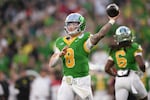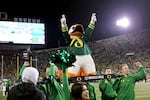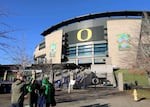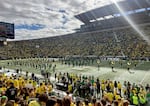
Oregon quarterback Dillon Gabriel (8) passes against Ohio State during the second half in the quarterfinals of the Rose Bowl College Football Playoff, Wednesday, Jan. 1, 2025, in Pasadena, Calif.
Kyusung Gong / AP
Not so long ago, when a student-athlete agreed to compete in an NCAA sport, they signed away their right to get paid for use of their name, image or likeness, commonly referred to as NIL. Their sole reward was an education, often with the help of an athletic scholarship.
That changed in 2021.
Before then, the NCAA used images of athletes in advertising, promotions and other marketing, but the student couldn’t be compensated — until nearly four years ago when the U.S. Supreme Court sided with a lower court that ruled the prohibition was unlawful.
The legal decision led to rapid changes in the way college sports operate, recruit and fundraise. And more changes to student-athlete NIL are coming this year that experts say will shift the college sports landscape once again.
Throughout the twists and turns, the University of Oregon is expected to dominate the college sports scene when it comes to attracting top athletes and maintaining a robust athletic department.
Oregon’s foundation for NIL
Driven by football revenue, the UO Athletic Department has been financially healthy for years. The department is self-sustaining, meaning it brings in at least as much money as it spends every year.
The top three funding sources are ticket sales, donations and media rights. Helping contribute to UO athletics’ financial health is major donor Phil Knight, Oregon alumnus and Nike co-founder.
So when the Supreme Court decision came down on NIL, UO had an advantageous foundation to build upon: The UO Athletic Department had decades of experience working with major donors like Knight and Oregon already had robust recruiting practices for student-athletes, especially for revenue-generating sports, namely football, with men’s and women’s basketball a distant second and third.
Now those relationships and recruiting experience have laid the groundwork for UO athletes to make the most of the new NIL world.

The University of Oregon cheer squad celebrates a Ducks touchdown on Nov. 24, 2023, as the Oregon Ducks took the lead over their rivals, the Oregon State Beavers.
Joni Land / OPB
Collectives
So far, it’s been a requirement that NIL deals are paid by third party entities, not schools.
That happens two ways: 1) a brand contracts with a student-athlete for an endorsement — most often through social media — and the third party organization helps facilitate, or 2) donors pool money through the third party group, which then contracts with student-athletes.
Jason Belzer is a Rutgers University adjunct professor in sports business law and former Rutgers football player. He’s worked in college sports for nearly two decades, and in summer 2021 Belzer started a company that runs some of those third party entities, called collectives.
He says many collectives are run similar to agencies that represent professional athletes. Belzer’s company has more than 40 collectives under its umbrella that work with athletes at schools ranging from Syracuse University in New York to the University of Hawai’i.
He has no affiliation with the third party group supporting UO athletes, Division Street, which declined to make someone available for an interview for this story. Division Street was created by major Oregon donors like Knight and former UO athletic director Pat Kilkenny, according to its website.
“It’s an independent entity that’s the collective for the university,” Belzer explains. “Its job is to contract with student-athletes to do endorsement activity.”
The majority of NIL deals fall under category No. 2, which are like “synthetic NIL,” Belzer said, “meaning donor money that goes into a collective and then is used to contract with athletes to do certain deliverables like promoting the collective, community service, all of those different pieces.”
Related: University of Oregon bets on top-ranked Ducks to defeat budget dilemma
These “synthetic” deals prioritize using lucrative NIL contracts to land the strongest athletes in highly competitive sports. The details of what a student-athlete would be expected to do in exchange are often an afterthought.
Those types of deals where the money comes in through the collective before the activity for compensation is identified, Belzer said, are nearly exclusively for football and men’s basketball players. Contracts vary widely in amount, but someone like UO quarterback Dillon Gabriel can expect nearly $2 million in NIL compensation.
Direct pay to athletes
Belzer said the role of collectives could shrink later this year, however. That’s because of a settlement allowing college athletic departments to share revenue directly with student-athletes.
“Schools will be allowed to compensate their athletes through direct NIL contracts,” he said. “Previously the NCAA disallowed institutions to contract directly with the students. Now they will be able to spend up to 20% of the average revenue of the power conferences — so that equates to about $20 million a year.”
That could create two different revenue paths for student-athletes to take advantage of NIL deals: They could receive money directly from their university, and the affiliated collective may continue to contract with athletes.
Belzer said schools with small donor bases could struggle to keep up, but not Oregon. Instead, he predicts athletes in revenue-generating sports will get direct payments from the UO and will have further compensation opportunities through Division Street.

The outside of the University of Oregon's Autzen Stadium in Eugene, Ore., on Nov. 24, 2023.
Joni Land / OPB
How the transfer portal fueled NIL
Steven Rackley, a sports management professor at Rice University, says there’s another important thing to understand about how NIL has changed college athletics: the Supreme Court decision hit around the same time NCAA rules around transferring schools loosened.
Prior to 2021, there were significant barriers for athletes who wanted to switch schools.
“Essentially the schools held all the cards,” Rackley said. “The schools controlled whether or not you can transfer. I mean — you can always just leave and show up someplace and register and all that stuff — but quite often, if you transferred within the conference, you may have to sit out two years and you’d lose a year of eligibility.”
Starting in 2021 the NCAA started to allow athletes in good academic standing to transfer schools and start play immediately. At first athletes could just do this once, but as of last year, athletes are able to enter the transfer portal more than once.
Quarterback Gabriel, for example, played a handful of seasons at University of Central Florida and University of Oklahoma before transferring to Oregon in 2024.
Rackley said that means colleges are recruiting both from high school and each other, putting pressure on athletic departments without deep pockets. On the flip side, schools with sound financial backing and NIL opportunities like the University of Oregon have an edge.
“It would’ve been nice to get your arms around one before you got your arms around the other one,” Rackley said, referring to the coinciding changes to transfer and NIL rules. “It just created this whole chaos that blew up the NCAA, to a certain extent.”
Rackley and others have referred to the first few years of athlete NIL as the “wild west.” Schools, athletes, brands and donors are trying to figure out the guidelines as they are constantly shifting, and Rackley doesn’t see that changing in the near future.

Fans pack Autzen Stadium in Eugene on Oct. 25, 2024, as the #1-ranked Oregon Ducks played University of Illinois. Oregon went on to win the game, 38-9, and retain the top ranking in the country.
Julia Boboc / OPB
UO’s internal edge for sports beyond football
A lot of headlines and jaw-dropping figures for student athlete NIL tend to be reserved for high profile football players. But the majority of student-athletes are participating in non-revenue generating sports like track, soccer, softball and volleyball.
Those students are good candidates to work with the Oregon Accelerator — UO’s unique student-run initiative that offers opportunities to mainly sports business and media majors to work directly with student-athletes on NIL opportunities.
“It’s good for the student-athlete, they get diverse perspectives when they’re trying to figure out how to do NIL,” Julia Rood, a senior sports business major at UO and general manager of Oregon Accelerator, said. “It’s also good for the Accelerator’s students because a business student gets to see how to do public relations — or do advertising, the more creative side of things. I think it’s really special.”
Kelli Matthews, UO public relations professor and co-faculty director of the Accelerator, estimates only a couple other schools have programs like it. Matthews said the Accelerator works with around 50 student-athletes who either want to explore NIL opportunities or who already have a deal with a brand and need to create content.
Since they don’t work with high-profile athletes, Matthews doesn’t see the role of the Accelerator changing when schools are able to directly share revenue later this year.
Instead, she said the Accelerator will continue to offer a unique option for student-athletes that only expect to make a few hundred dollars from NIL deals. Matthews said NIL gives the university athletes an opportunity to develop marketing and networking skills, and could help them put away money for things like nursing school, which she says some softball players are doing.
“Most student-athletes are using this as a supplement just to be able to provide some financial cushion,” Matthews said, “Or get some free products, or have a trip or get access to an experience that they might not have otherwise.”
